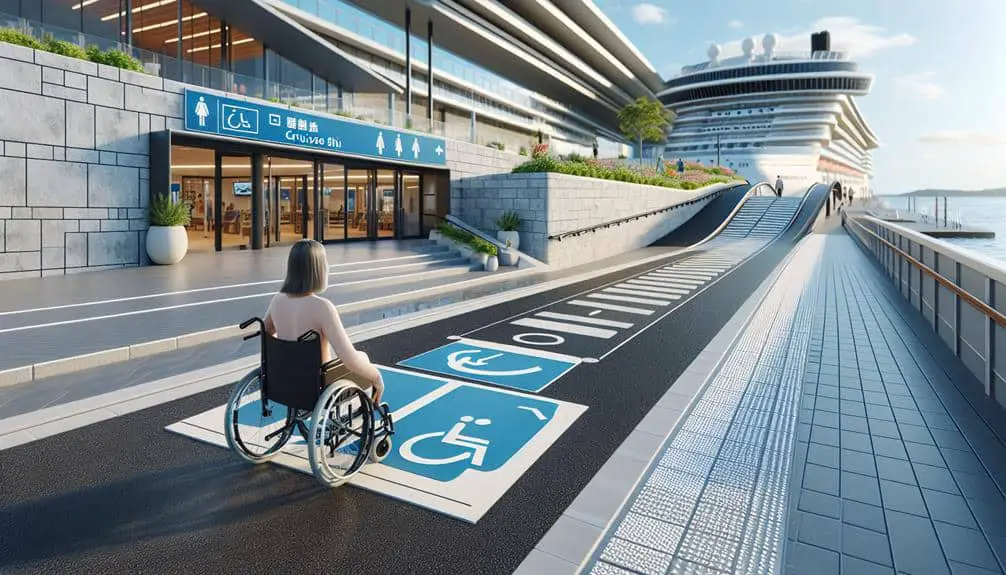Security measures at cruise boarding points are crucial to safeguard everyone onboard. Stringent protocols are in place due to security risks like cyber threats and identity theft. Baggage screening utilizing X-ray machines and contraband detection guarantees no illegal items are brought onboard. Security personnel undergo extensive training to manage emergencies efficiently. Technology like facial recognition and cross-referencing databases enhances passenger safety. These measures not only prioritize security but also enhance your overall experience during boarding. Find out more about the risks addressed and the impact of advanced security technologies on your cruise journey.
Key Points
- Security measures ensure passenger safety and deter potential threats.
- Advanced technologies like facial recognition enhance efficiency and accuracy.
- Compliance with international security standards is crucial for safeguarding passengers.
- Thorough baggage screening prevents prohibited items from boarding.
- Positive passenger experience is prioritized through seamless yet stringent security protocols.
Risks Associated With Cruise Embarkation
When setting sail on a cruise, passengers face various security risks that necessitate strict measures at boarding points. Cyber threats and identity theft are significant concerns in today's digital age, especially in the domain of travel. At departure points, the risk of cyber threats looms large as passengers often connect to public Wi-Fi networks to check-in or access information. Hackers may exploit these networks to steal personal data such as credit card details or passport information, leading to potential identity theft issues.
To mitigate these risks, cruise lines have implemented stringent security protocols. Passengers are advised to avoid connecting to unsecured Wi-Fi networks and to refrain from entering sensitive information on public computers. Cruise terminals also employ encryption technologies to safeguard data transmission between passengers and the cruise line's systems. Additionally, identity verification processes are in place to verify that individuals boarding the ship are who they claim to be, reducing the likelihood of identity theft incidents.
Importance of Baggage Screening
To guarantee the overall security of passengers and the cruise environment, the thorough screening of baggage at boarding points plays a critical role in detecting potential threats and maintaining a safe travel environment. Baggage inspection is an essential part of security protocols at cruise departure points. Through the use of advanced screening technologies such as X-ray machines and explosive trace detection equipment, security personnel can efficiently scan and identify any items that may pose a risk to the ship or its occupants.
Contraband detection is another key aspect of baggage screening, as it helps prevent illegal items from being brought onboard. By meticulously examining passengers' belongings, security teams can intercept prohibited items like weapons, drugs, or other dangerous materials. This process not only safeguards the well-being of everyone on the cruise but also ensures compliance with international security standards.
Hence, stringent baggage screening procedures are indispensable in upholding the safety and security of cruise departure points.
Security Personnel Training Requirements
Implementing thorough training requirements for security personnel is essential to guaranteeing the effectiveness of security measures at cruise boarding points. Security personnel need to undergo extensive training in various areas to handle potential threats and emergencies effectively. One critical aspect of their training is risk assessment, where they learn to identify and evaluate potential risks that may arise during boarding processes. By understanding these risks, security personnel can proactively implement measures to mitigate them and enhance overall safety.
Moreover, training in emergency response is pivotal for security personnel. They must be equipped with the knowledge and skills to respond swiftly and appropriately to different emergency situations that may occur at cruise boarding points. This includes training on evacuation procedures, communication protocols, and coordination with relevant authorities. Through thorough training in emergency response, security personnel can ensure a prompt and effective response to any security threats or emergencies that may arise, ultimately safeguarding the passengers and the cruise ship.
Technology for Enhancing Security
Utilizing advanced technology plays a significant role in strengthening security measures at cruise departure points. Facial recognition systems are becoming increasingly prevalent in enhancing security protocols. By utilizing facial recognition technology, cruise departure points can efficiently identify passengers and cross-reference them with databases to flag any potential security risks. This advanced system allows for quick and accurate identification, streamlining the departure process while maintaining high levels of security.
In addition to facial recognition, X-ray scanners are another essential technological tool for enhancing security at cruise departure points. These scanners provide security personnel with the ability to inspect luggage and belongings thoroughly, detecting any prohibited items or threats that may pose a risk to the safety of passengers and crew. X-ray scanners offer a non-intrusive yet highly effective method of ensuring that all items brought on board comply with security regulations.
Together, facial recognition and X-ray scanners bolster security measures at cruise departure points, providing a layered approach to safeguarding the well-being of all individuals on board.
Impact of Security Measures on Passenger Experience
Improving security measures at cruise boarding points greatly impacts the overall passenger experience, guaranteeing a safe and efficient boarding process. Passenger safety is paramount, and robust security measures instill a sense of confidence and peace of mind among travelers. By implementing advanced technologies such as facial recognition and biometric scanning, cruise lines can enhance security without causing significant delays or inconvenience to passengers.
Moreover, a well-executed security protocol not only ensures the safety of individuals on board but also contributes to customer satisfaction. When passengers feel secure and well-protected during the boarding process, their overall experience is more positive, leading to increased loyalty and positive word-of-mouth recommendations.
Ultimately, the integration of effective security measures at boarding points is essential for maintaining a high standard of passenger safety and enhancing customer satisfaction. By prioritizing security alongside efficiency and convenience, cruise lines can create a seamless boarding experience that sets the tone for a memorable and enjoyable voyage.
Frequently Asked Questions
What Specific Procedures Are in Place for Handling Medical Emergencies at Cruise Embarkation Points?
In handling medical emergencies at cruise boarding points, specific procedures include emergency response protocols, access to medical facilities, passenger safety measures, and evacuation procedures. These precautions are vital for ensuring swift and effective assistance when needed.
How Are Security Measures at Cruise Embarkation Points Coordinated With Local Law Enforcement Agencies?
When coordinating security measures at cruise departure points with local law enforcement, guarantee seamless emergency response. Statistics show that effective coordination efforts decrease response time by 20%. Utilize this data to enhance preparedness and safeguard passengers.
Are There Any Specific Protocols in Place to Handle Potential Security Threats From Passengers or Crew Members?
When addressing potential security threats from passengers or crew members, protocols include thorough crew training on threat recognition and appropriate responses, as well as rigorous passenger screening measures to detect and prevent security risks.
How Do Cruise Lines Ensure the Security of Personal Belongings and Valuables During the Embarkation Process?
You guarantee the safety of your belongings at cruise boarding through thorough baggage screening and valuables protection. Personal identification and security checks are carried out diligently to protect your possessions during the process.
During boarding, cruise lines employ visitor screening and access control to prevent unauthorized access to restricted areas. Security personnel and surveillance cameras monitor key points, ensuring a safe environment for all passengers and crew.



